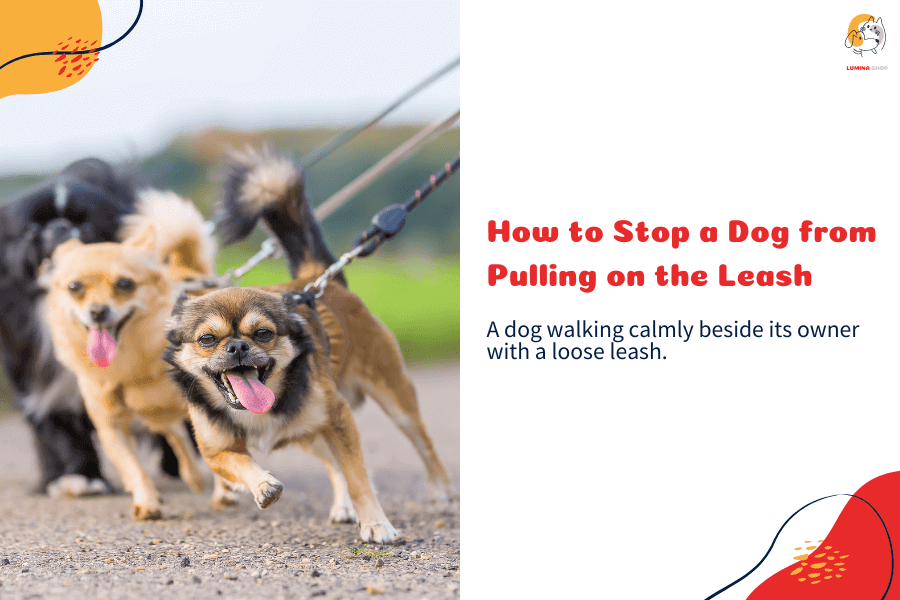
how to stop a dog from pulling on the leash ?
Walking your dog should be an enjoyable experience, but if your dog constantly pulls on the leash, it can turn into a frustrating struggle. Whether they’re excited, distracted, or simply not trained to walk politely, leash pulling is a common issue many dog owners face.
The good news? With patience, consistency, and the right training techniques, you can teach your dog to walk calmly beside you. In this guide, we’ll cover the reasons why dogs pull on the leash, training methods to stop leash pulling, and the best tools to help with loose-leash walking.
Recommended Product:
No-Pull Dog Harness – Designed to reduce pulling and make walks more enjoyable.

1. Why Do Dogs Pull on the Leash?
Before you can correct leash pulling, it’s important to understand why dogs do it:
Excitement and Overstimulation
Dogs love walks! They get excited by sights, sounds, and smells, leading them to charge forward to explore.
Lack of Leash Training
If a dog hasn’t been taught to walk politely on a leash, pulling becomes a habit.
Opposition Reflex
Dogs have a natural resistance to restraint—when they feel tension on the leash, they instinctively pull against it.
Desire to Lead
Some dogs naturally try to take the lead on walks, especially confident or high-energy breeds.
Reinforced Behavior
If a dog pulls and gets what they want (moving forward), they learn that pulling is effective.
Recommended Product:
Adjustable Training Leash – Helps control pulling with different leash lengths.

2. How to Stop Your Dog from Pulling on the Leash
1. Use the Right Equipment
The right gear makes a big difference in leash training.
✔ No-Pull Harness: A no-pull harness reduces pulling by redirecting your dog’s motion.
✔ Training Leash: A 4-6 foot leash offers better control than retractable leashes.
✔ Treat Pouch: A treat pouch keeps rewards handy for positive reinforcement.
2. The Stop-and-Start Method
If your dog pulls, stop walking immediately. Wait until the leash loosens, then continue. Over time, your dog will learn that pulling gets them nowhere.
3. The "Turn Around" Technique
Whenever your dog pulls, turn in the opposite direction. This helps them learn to pay attention to you instead of leading the walk.
4. Reward Good Behavior
Whenever your dog walks nicely without pulling, reward them with a treat or praise. Use training treats to reinforce positive behavior.
5. Use Verbal Cues
Teach commands like:
- "Easy" – to slow down.
- "Heel" – to walk beside you.
- "Let's go" – to continue forward.
6. Practice Loose-Leash Walking in Low-Distraction Areas
Start in quiet environments like your backyard before progressing to busy streets or parks.

3. Common Mistakes to Avoid
Pulling Back on the Leash
Pulling against your dog only triggers opposition reflex, making them pull harder.
Using the Wrong Equipment
Retractable leashes and back-clip harnesses can encourage pulling rather than prevent it.
Allowing Inconsistent Behavior
Letting your dog pull sometimes but not always confuses them—be consistent.
Skipping Mental Stimulation
A bored dog is more likely to pull. Use interactive toys to keep them engaged outside of walks.

4. How Long Does It Take to Train Loose-Leash Walking?
Every dog learns at a different pace. Some may improve in a few days, while others take weeks of consistent training. Patience is key!
Tips for Success:
✔ Keep training sessions short (5-10 minutes at a time)
✔ Always end on a positive note
✔ Be patient and celebrate small improvements

5. Best Tools to Help Stop Leash Pulling
Using the right tools can make leash training easier and more effective:
🦴 No-Pull Dog Harness – Redirects pulling safely.
🦴 Adjustable Training Leash – Provides better control on walks.
🦴 Treat Pouch for Training – Keeps rewards handy for positive reinforcement.
🦴 Training Treats – Encourages good behavior.

Conclusion
Leash pulling is frustrating, but with patience, consistency, and the right training techniques, your dog can learn to walk politely by your side.
Start with proper gear, reward good behavior, and practice daily. With time, walks will become enjoyable for both you and your dog!
Check out Lumina Pet Shop for high-quality no-pull harnesses, training leashes, and treats to support your training journey.
Happy walking! 🐾
